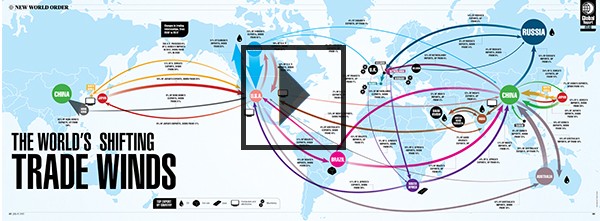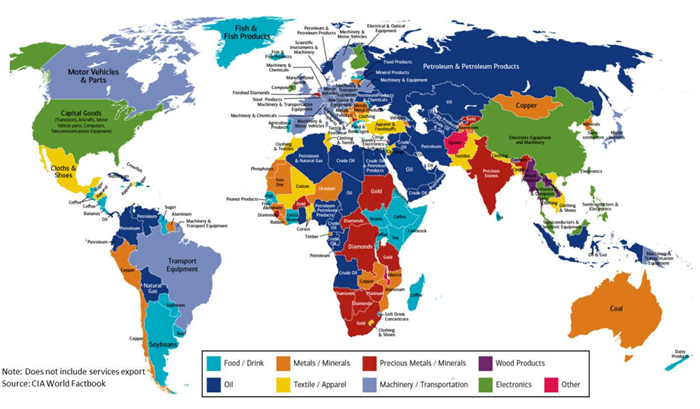CGW4U
World Issues: A Geographic Analysis
Unit 2: Asia
Activity 5: When is free trade or protectionism best?
When is free trade or protectionism best? There is a simple answer to the question, but it depends who you talk to!
Not only must we fight to end disastrous unfettered free trade agreements with China, Mexico, and other low wage countries, we must fight to fundamentally rewrite our trade agreements so that American products, not jobs, are our number one export.
Free trade, far from protectionism, is the path that we should take to make Latin America a thriving actor in the global economy.
Trade has become an increasingly important part of our local economy and also our global economy. What we trade, who we trade with, what restrictions we place on our imports, and those placed on our exports are issues for every country on the planet.
Click the image below to visit Canadian Business to view the interactive map about the ever-shifting trends in world trade.

You will have seen from the interactive map at the Canadian Business website that there is a shift in trade globally. China is the world's largest exporter and will soon become its largest importer.
What do you think?
- Is this a positive change for China’s trading partners?
- Is this good for Canada?
- What data can you use to support your position?
Use the infographics below to add to your thinking.
According to the interactive map and the above infographics...
- What can you identify as a significant trend?
- Have you ever considered the value of trade globally?
- Why should we be aware of global trade patterns and trends?
You may be surprised by some of the information on the following map. Did you know that Australia’s major export is coal, or that Canada’s is motor vehicles and parts? The fact is we all do it. We all trade.
According to the World Trade Organization's International Trade Statistics 2015, the value of commercial service exports was USD 4.872 Trillion in 2014. Exports of merchandise in that same year was valued at USD 19.002 Trillion. Those are huge numbers representing activities that impact every single person and place on the earth. Trade, from the get go, has driven globalization.
Take a moment and be sure you are familiar with the following terms (click on the term to reveal its definition):
 Shifting Trade Winds
Shifting Trade Winds
Certainly there are advantages and disadvantages to trade, free trade and protectionism.
Go back to the interactive map of Shifting Trade Winds at the Canadian Business website and find evidence of these advantages and disadvantages of international trade.
Create a T-chart that allows you to record the evidence you have found for both the advantages and the disadvantages of international trade. Next, record your current opinion on international trade. This will help you later in the activity as you think about the more complex issue of protectionism versus free trade.
Analysing the Issue of Free Trade
Analysis is the detailed examination of something by breaking it apart for closer inspection and questioning. To make an analysis of free trade less daunting, we can use a geographic perspective as a framework to guide us.
We will start our analysis with what might appear to be a very basic question: When is free trade or protectionism best?
 Economic issues arising from Free Trade
Economic issues arising from Free Trade
Use the following articles from Cron.com, the online Houston Chronicle website to make your own notes that will help you to summarize the economic advantages and disadvantages of free trade.
If you want to follow any links in the documents, right click and select "Open Link in New Tab" to avoid leaving this page.
 Free Trade vs Protectionism
Free Trade vs Protectionism
While newspaper articles become dated very quickly, they do capture the situation at the time of publication. For our purposes then, we can use articles that are not absolutely current. Again focussing on only the economics of free trade versus protectionism, take notes on these news articles:
If you want to follow any links in the documents, right click and select "Open Link in New Tab" to avoid leaving this page.
 When is free trade or protectionism best?
When is free trade or protectionism best?
When you have completed your notes, write a conclusion or summary statement (in a few sentences) for this part of your inquiry: When is free trade or protectionism best? Share your summary with one other person in your class to compare your findings and resulting summary. Give your partner feedback using the “Praise, Question, Polish” Peer Assessment Strategy.
 Political Issues
Political Issues
While we are continuing with our inquiry question: “When is free trade or protectionism best?” we need to now consider the political implications.
Research the political advantages and disadvantages of the Trans Pacific Partnership (TPP).
To do this, find two articles, each from different TPP countries. Cite your articles and take notes that illustrate the political pros and cons for this particular trade agreement.
Google News is a good tool to use to assist you in finding articles on The Trans Pacific Partnership (TPP).
Write your conclusion, (in 4-5 sentences) about the political impacts of free trade and protectionism. Include specific examples from your research to support your position. Did you come to the same conclusion you did when you were considering this issue from an economic viewpoint?
| Self-assessment checklist for discussion questions: | Check |
|---|---|
| Did I use the question to start my answer? | |
| Did I use facts, terms, definitions or evidence to support my answer/opinion? | |
| Did I answer what is being asked of me such as... Who? What? Where? When? Why? and/or How? |
|
| Does my response communicate the key/important components of the question? | |
| Did I use appropriate written conventions, vocabulary, and terminology from this course? | |
| Did I contribute new information to the discussion? | |
| Have I made connections to the ideas already shared? Ideas discussed in this activity or course? |
Environmental Issues
Free trade is driven by many things, one of which is corporate profit. “If we manufacture it in country X, we make less profit than if we make it in country Y.” Historically trade agreements did not extend to protection of the environment. While this has been changing, the damage done by corporations in the past still lingers.
See the kinds of disasters that have happened when corporations, focussed on profit, cut corners and in turn damage the natural environment. Click on the icons in the interactives below to access articles, videos and photos about the environmental issues related to globalization.
Social Issues
Trade has a large impact on politics, economics and the environment. What impact does it have on individuals? Does the impact depend if they live in a LEDC or an MEDC?
If you want to follow any links in the document, right click and select "Open Link in New Tab" to avoid leaving this page.
 Environmental Control and Social Advantages
Environmental Control and Social Advantages
Select one of the two topics below about which to contribute your thoughts.
1. What kind of environmental controls do you think need to be in free trade agreements? Clearly state your position and use specific facts from the information provided in the content above to support your thinking.
2. Use your thinking about the economic, political and environmental implications of free trade versus protectionism to infer the social advantages of free trade versus protectionism - how do free trade and protectionism both help and harm people? Do your ideas include people in LEDCs and MEDCs?
In the next activity we will take an in depth look at the lives of people engaged in manufacturing for export.
 When is free trade or protectionism best?
When is free trade or protectionism best?
Based on your readings, thinking and discussions, you have a collection of work in your notebook that indicates your thinking about free trade and protectionism.
- Would you wholly support a trade agreement like the TPP?
- Would you want to see some restrictions?
- Would you refuse to consider another free trade agreement at this time?
- Would your decision change if you were approaching this from the perspective of an LEDC?
Using this organizer answer the question that has driven this activity: When is free trade or protectionism best? Your responses should be fully developed and meaningful and illustrate your thinking.
 Annotated Bibliography for your Position Paper
Annotated Bibliography for your Position Paper
Your teacher will have provided you with feedback on your globalization article annotation. Now it is time to begin research for your position paper.
In Unit 1 you selected an appropriate world issue for this evaluation. Now, to show that you can find and assess appropriate resources for your position paper you will complete an annotated bibliography. It will have five sources each with an annotation. Review the feedback your teacher has already given you to improve your product.
Self-Assessment: Annotated Bibliography Checklist
Does my annotated bibliography include...
| Criteria | Yes, I did it well. | No, I need to work on it. |
|---|---|---|
| Content: I have included appropriate...
|
||
| An assessment of the value of the source (complete 4-5 of the following): I am able to state the…
|
||
| Writing Style: My writing has suitable...
|
||
| Overall: My annotated bibliography…
|
